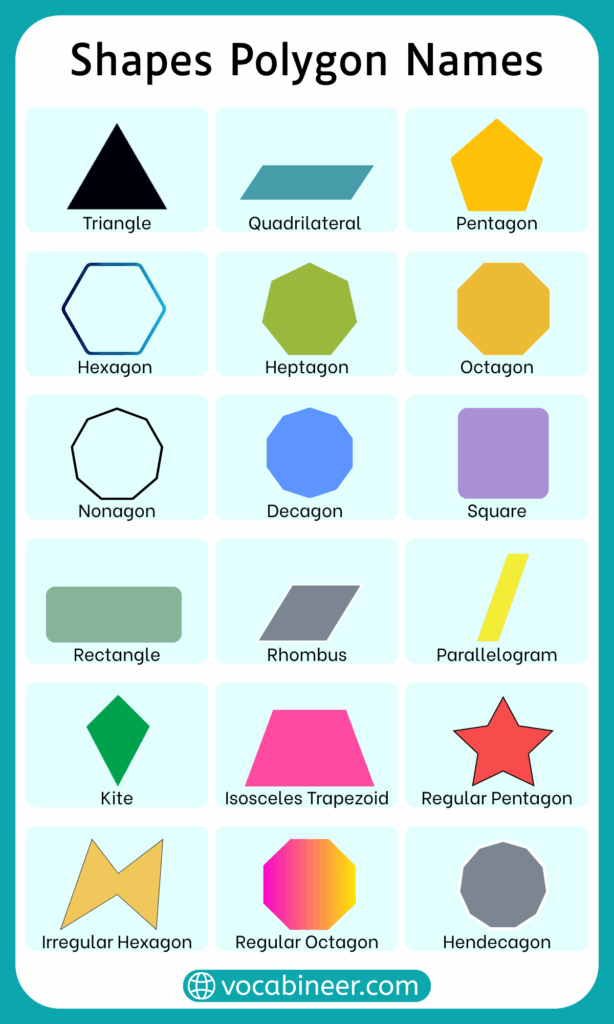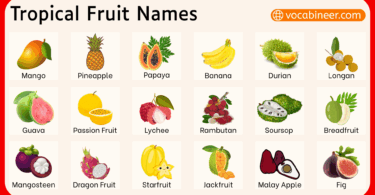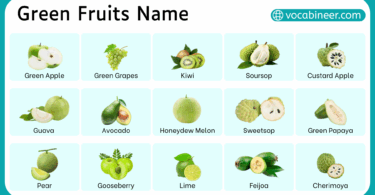Children often learn polygon shapes names with their pictures to connect numbers with different shapes. A polygon is a flat closed figure made of straight sides, and each one is named according to the number of its sides. In this article, you will study polygon names in order, from triangles and hexagons to rarer shapes. These names are important in math, design, and describing everyday objects.
In This Page
What Is a Polygon?
A polygon is a flat figure made with straight lines that meet at corners. The name of a polygon comes from its number of sides. For example, a 3 sided polygon is a triangle and a 6 sided polygon is a hexagon. Polygons can be regular, with equal sides and angles, or irregular, with sides of different lengths.
Names of Polygons by Number of Sides
Every polygon has a name that depends on its side count. A triangle has three sides, a hexagon has six, and larger polygons follow the same pattern. The list includes each name with a short description and everyday example.
- Name of a 3 sided polygon: A triangle has three sides. It looks like a pizza slice, a sail, or a road sign.
- Name of a 4 sided polygon: A quadrilateral has four sides. Common types are squares, rectangles, rhombuses, trapezoids, and kites.
- Name of a 5 sided polygon: A pentagon has five sides. It appears in house roof drawings, logos, and starfish shapes.
- Name of a 6 sided polygon: A hexagon has six sides. Honeycombs, nuts, bolts, and tiles often use this pattern.
- Name of a 7 sided polygon: A heptagon has seven sides. Rare, but found in coins, geometry, and design art.
- Name of an 8 sided polygon: An octagon has eight sides. The stop sign is the most popular example.
- Name of a 9 sided polygon: A nonagon has nine sides. Used in decorative clocks, puzzles, and advanced tiling.
- Name of a 10 sided polygon: A decagon has ten sides. Seen in board game tokens and math projects.
- Name of an 11 sided polygon: An undecagon or hendecagon has eleven sides. Used mostly in math lessons.
- Name of a 12 sided polygon: A dodecagon has twelve sides. Seen in coins, calendars, and clock faces.
- Name of a 13 sided polygon: A tridecagon has thirteen sides. Rare, used in math exercises.
- Name of a 14 sided polygon: A tetradecagon has fourteen sides. Sometimes found in mosaic art and tiling.
- Name of a 15 sided polygon: A pentadecagon has fifteen sides. Mostly appears in advanced geometry.
- Name of an 18 sided polygon: An octadecagon has eighteen sides. A shape for geometry study.
- Name of a 20 sided polygon: An icosagon has twenty sides. Used in dice for board games and math models.

Common Polygon Names for Kids to Learn
Children usually start with common polygon names because they are easy to recognize. Shapes like triangles, squares, and rectangles appear in food, toys, and buildings. Learning these names builds the base for understanding harder shapes later on.
- Triangle: Three sides, seen in pyramids, sails, and sandwiches.
- Square: Four equal sides, found in tiles, games, and boxes.
- Rectangle: Four sides with equal opposite sides, used in doors, notebooks, and screens.
- Pentagon: Five sides, noticed in flowers, logos, and sport field designs.
- Hexagon: Six sides, famous in honeycomb structures.
- Heptagon: Seven sides, used in coins and patterns.
- Octagon: Eight sides, the shape of stop signs.
- Nonagon: Nine sides, sometimes used in art and puzzles.
- Decagon: Ten sides, useful in tiling and decorative work.
All Names of Polygons from 1 to 20
Polygon names follow a number order from one side to twenty sides. A monogon has one side, a decagon has ten, and an icosagon has twenty. The table makes these names easier to compare at a glance.
| Number of Sides | Name of Polygon | Example Use |
|---|---|---|
| 1 | Monogon | Used in theory only |
| 2 | Digon | Geometry study shape |
| 3 | Triangle | Pizza slice, sail |
| 4 | Quadrilateral | Windows, books |
| 5 | Pentagon | Flower petals |
| 6 | Hexagon | Honeycomb |
| 7 | Heptagon | Coin designs |
| 8 | Octagon | Stop sign |
| 9 | Nonagon | Decorative art |
| 10 | Decagon | Puzzle pieces |
| 11 | Undecagon | Math models |
| 12 | Dodecagon | Coins, clocks |
| 13 | Tridecagon | Geometry puzzles |
| 14 | Tetradecagon | Mosaic art |
| 15 | Pentadecagon | Geometry |
| 16 | Hexadecagon | Math |
| 17 | Heptadecagon | Advanced geometry |
| 18 | Octadecagon | Geometry lessons |
| 19 | Enneadecagon | Rarely used |
| 20 | Icosagon | Game dice |
Groups of Polygons and Their Names
Polygons are divided into groups based on their sides and angles. These groups help kids see patterns in shapes.
- Regular and irregular polygons: Regular polygons, like squares and hexagons, have equal sides. Irregular polygons, like trapezoids or rectangles, have unequal sides.
- Convex and concave polygons: Convex polygons push outward, like a hexagon. Concave polygons have a dent inward, like a star.
Advanced Polygon Names Beyond 20 Sides
Polygon names continue past twenty sides, though they are not common in daily use.
- Tridecagon and tetradecagon: Tridecagon has 13 sides, tetradecagon has 14 sides. Both appear in advanced tiling and puzzles.
- Icosagon and higher polygon names: An icosagon has 20 sides. Beyond this, names follow Greek number prefixes, such as 30 sides (triacontagon) or 100 sides (hectogon).
Names of Polygons Seen in Daily Life
Learning is easier when kids notice shapes around them. Many foods, toys, and buildings are polygons.
- Names of polygon shapes in toys: Blocks may be cubes, puzzles have triangular edges, and board games use hexagon grids.
- Names of polygon shapes in food: Pizza slices are triangles, crackers are squares, and waffles are filled with hexagons.
- Names of polygon shapes in buildings: Roofs look like triangles, windows may be rectangles, and floors often use octagon tiles.
- Names of polygon shapes in nature: Snowflakes look like hexagons, crystals often form polygons, and some flowers open as pentagons.
FAQs About Polygon Names
A polygon with seven sides is called a heptagon. This shape is not very common in daily objects, but it may appear in coins, design patterns, or art. In math lessons, heptagons help students practice identifying less familiar polygons.
A polygon with twelve sides is known as a dodecagon. Dodecagons are used in coins, some clock faces, and tiling patterns. The name comes from the Greek prefix “dodeca,” meaning twelve, joined with “gon,” which means angle.
A polygon with twenty sides is called an icosagon. This large shape is not common in everyday life, but you may see it in dice for games or in advanced geometry. The word “icosa” comes from the Greek prefix for twenty.
Any four-sided polygon is called a quadrilateral. Subtypes include square, rectangle, trapezoid, rhombus, parallelogram, and kite. Each one has its own special features, such as equal sides, parallel sides, or diagonal angles, which make them useful in design, architecture, and math.
Irregular polygons are shapes where sides or angles are not equal. They include trapezoids, parallelograms, rhombuses, and kites. These polygons are important because they appear more often in real objects like windows, roofs, and decorations than perfectly regular polygons such as squares or hexagons.
Read More




